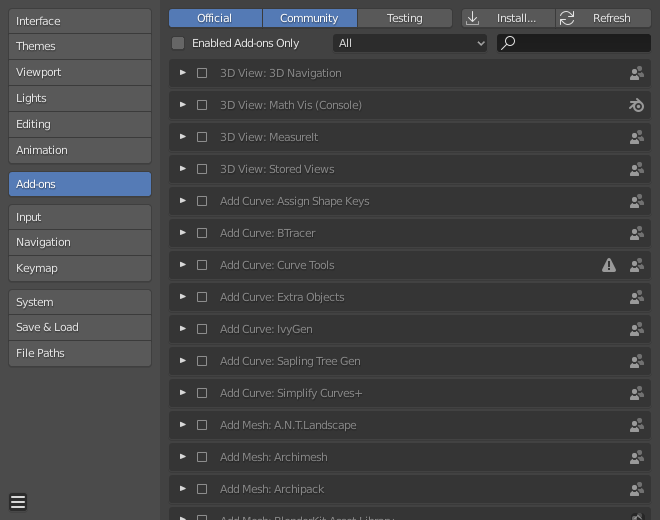Complementos¶
The Add-ons section lets you manage secondary scripts, called «Add-ons» that extends Blender’s functionality. In this section you can search, install, enable and disable Add-ons.

Blender Preferences Add-ons section.
Finding Add-ons¶
- Pesquisando complementos
- Blender comes with some pre-installed Add-ons already, ready to be enabled. But you can also add your own, or any interesting ones you find on the web.
- Nível de suporte
Os complementos do Blender são divididos em dois grupos dependendo de quais pessoas ou entidades escreveram e / ou fornecem suporte aos mesmos:
- Oficial: Complementos que são escritos pelos desenvolvedores do Blender.
- Comunitário: Complementos que são escritos pelas pessoas dentro da comunidade Blender.
- Enabled Add-ons Only
- Shows only enabled add-ons for the current Category.
- Category
- Os complementos são divididos em categorias referenciadas por quais áreas do Blender serão afetadas.
Habilitando e desabilitando complementos¶
Enable and disable an add-on by checking or unchecking the box to the right of the add-on you chose, as shown in the figure below.

Enabling an add-on.
The add-on functionality should be immediately available.
Nota
Add-ons that activate or change multiple hotkeys have a special system of activation. For example, with the «UI: Pie Menu Official» add-on for each menu there’s a selection box to activate the menu and its hotkey.
Dica
If the Add-on does not activate when enabled, check the Console window for any errors that may have occurred.
3rd Party Add-ons¶
There are hundreds of add-ons that are not distributed with Blender and are developed by others. To add them to the list of other add-ons, they must be installed into Blender.
To install these, use the Install… button and
use the File Browser to select the .zip or .py add-on file.
Now the add-on will be installed, however not automatically enabled. The search field will be set to the add-on’s name (to avoid having to look for it), Enable the add-on by checking the enable checkbox.
- Atualizar
- Scans the Add-on Directory for new add-ons.
Dica
User-Defined Add-on Path
You can also create a personal directory containing new add-ons and configure your files path in the File Paths section of the Preferences. To create a personal script directory:
- Crie um diretório vazio em uma localização de sua escolha (por exemplo:
meus_scripts). - Adicione um subdiretório dentro da pasta
meus_scriptschamadoaddons(ele deverá usar este nomeaddonspara que o Blender o reconheça adequadamente). - Open the File Paths section of the Preferences.
- Set the Scripts file path to point to your script directory (e.g.
my_scripts). - Save the preferences and restart Blender for it to recognize the new add-on location.
Now when you install add-ons you can select the Target Path when installing 3rd party scripts. Blender will copy newly installed add-ons under the directory selected in your Preferences.
Informações sobre complementos¶
Você pode clicar na seta na lateral superior esquerda da caixa do complemento para mais informações, como a sua localização, uma descrição mais detalhada ou uma ligação que o vincule a sua documentação. Aqui você também poderá encontrar um botão para relatar defeitos específicos deste complemento.
Preferências de complementos¶
Some add-ons may have their own preferences which can be found in the Preferences section of the add-on information box.
Some add-ons use this section for example to enable/disable certain functions of the add-on. Sometimes these might even all default to off. So it is important to check if the enabled add-on has any particular preferences.